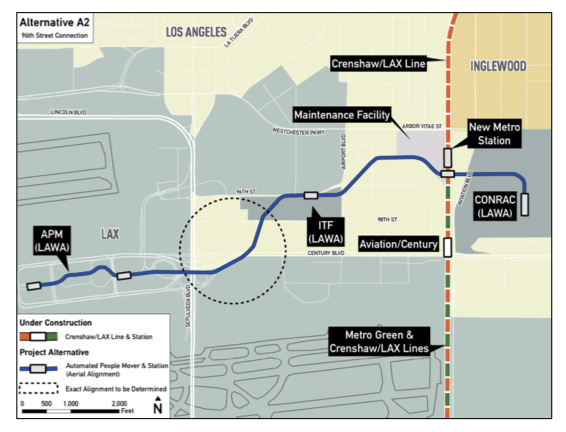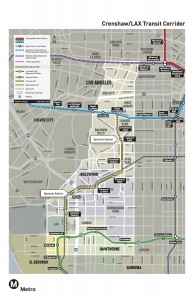In my 2014 book Railtown, I covered the sad saga of Los Angeles rail transit planners’ failed attempt to bring rail to LAX (Los Angeles International Airport). While local conspiracy theorists argued that the taxi industry had scuttled the plan, the reality was that the region was running out of money for rail anyway and lacked consensus on the best route to the airport.
But transit officials at the time also cited resistance from airport officials, as I described in the book:
Many local leaders blamed the airport for the impasse, arguing that airport leaders should have been willing to contribute funds for the extension. “If [the airport] had used passenger facility funds to meet the line, we would have gone there and made it happen,” said [transportation commissioner Jacki] Bacharach. “But we never got help from the airport.” According to Ruth Galanter, who represented the area at the Los Angeles City Council, airport officials cited a federal law that prevented airport revenues from funding anything other than airport improvements. “The airlines said, ‘No way. The people using the Green Line have nothing to do with the airport, so you can’t take this money.’ If Bradley had been around for another ten years, he probably could have worked out a compromise.”
I thought of that history when I saw today’s news in the San Francisco Chronicle that airports across the country are losing money from lost fee revenue with the advent of Uber and Lyft:
Travelers’ changing habits, in fact, have begun to shake the airports’ financial underpinnings. Fewer people are parking cars at airports, using taxis or renting cars, according to a recent report from the National Academies Press.
Those trends are hurting airports, which depend on fees from parking lots, rental-car companies and taxis as their biggest source of revenue other than the fees paid by the airlines. The money they collect from ride-hailing services does not compensate for the lower revenues from the other sources.
While LAX officials denied trying to shoot down a rail connection in the 1990s, this article makes it clear that rail transit connections are not exactly in their financial interest.
In the end, LAX is about to get a rail connection from the under-construction Crenshaw Line, which will connect to a parking lot nearby and an eventual people mover around the airport. But it comes a generation after a failed effort in the early 1990s, with the airport’s economic interest likely an important factor.
Los Angeles Metro released their staff recommendation for how to connect the future Crenshaw light rail line to LAX (Los Angeles International Airport). Metro’s “The Source” has a good summary with links to the relevant documents. Bottom line: Metro staff recommends an extra light rail station along the existing Crenshaw route to connect to a future automated “people-mover” train that would carry rail passengers to the airport. Here’s the map:
I generally like this option the best. As I discussed in a previous blog post, rail connections to airports are generally not huge rider magnets. The staff report, for example, projects that only 1-2% of all travelers will arrive at LAX by rail or bus. Sure, the airport expects over 60 million passengers a year, but relative to the thousands taking the Crenshaw line each day, not to mention the cost of bringing rail to the airport, it’s pretty puny. This option addresses that reality by not inconveniencing non-airport bound Crenshaw line riders with an unnecessary detour closer to the airport. Better to have the People Mover come to the Crenshaw line, rather than the other way around.
I also like the people mover stop at the future “Intermodal Transfer Facility” near Lot C. That will allow a host of off-site activities to take place, including possibly luggage check-in, car rental pickup/dropoff, and transit transfers.
But some big question marks: will LAX actually build the People Mover? I wouldn’t trust the airport to follow through, given its prior intransigence on allowing rail to the airport at all (as I discuss in Railtown). And will the People Mover just have a few central stops in the giant LAX horseshoe, or will it circulate around the terminals for maximum convenience (and ridership)? Finally, is it worthwhile to have an extra Crenshaw line stop for the people-mover just .4 miles north of the planned Century/Aviation stop? Seems like those stations are too close and would slow overall travel. But maybe there’s no better solution.
We’ll have to stay tuned to see how Metro directors — and the airport — respond to this sensible proposal.
The New York Times ran an article today discussing the challenges of bringing rail transit to Los Angeles International Airport (good ol’ LAX), and it features a quote from me about I why I think rail to the airport is more of a psychological victory than a ridership victory. Without further explanation, this quote may be confusing or controversial, so let me clarify.
Generally speaking, rail to airports is not the most desired mode of choice for travelers. If you’re lugging suitcases, and even worse if you’re traveling with small children, rail is logistically challenging and often quite stressful, especially before a big air trip. (Unfortunately I know this from experience, having traveled with all three of my young kids on long BART rides to SFO or via AirBART to Oakland.) It’s often cheaper, faster, and easier to drive and park at an economy, off-site lot.Meanwhile, wealthy travelers often prefer to take expensive cabs or luxury cars to the airport, and many other travelers have friends who can give them rides. In addition, super-shuttles are popular, as are some inexpensive bus connections (AC Transit to Oakland for example or the Santa Monica Big Blue or Culver City bus to LAX).
So right off the bat, rail to the airport is only going to appeal to a relatively small subset of passengers — probably the relatively less-affluent solo passengers.
Second, and more specific to Los Angeles, most travelers’ destinations and origins are so spread out across the metropolitan region that the likelihood of living, working, or recreating near an existing rail station to connect to LAX is not huge. Even worse, the spread-out nature of the urbanized city means that even if you did live, work, or recreate near rail, you would likely have to transfer a number of times to get to LAX, resulting in a trip that could often take hours and be fairly expensive, at least under the current fare structure. For example, if you lived in Pasadena, you would take the Gold Line to the Red Line to the Blue Line to the Green Line, which I’m guessing is about a two-hour trip.
By contrast, the flyaway shuttle from Union Station is cheap and convenient for those near or accessible to downtown LA. Travel modes like the shuttle are likely to get more usage than rail for far cheaper and without the big infrastructure build-out time and expense.
However, all is not doom and gloom when it comes to connecting LAX to rail. Here are some reasons for optimism: it will generate ridership, even if not the huge amount some might expect. In particular, airport employees will benefit as daily commuters. There will also be travelers for whom the Crenshaw line will provide quick service to their desired destinations (although that will probably be a small number of people). For example, in addition to destinations along the Crenshaw rail line, you could transfer from there to Santa Monica via a somewhat circuitous route or to downtown LA.
And more importantly, as Metro Rail gets fully built-out to reach major population, commercial and entertainment centers, the value of an airport connection will increase for both visitors and locals. The regional light rail connector through downtown will make possible a one-seat ride to Pasadena from LAX, eliminating the transfer mess I described above. A Crenshaw light rail connection to the Purple Line subway (not currently in the plans) could get travelers to Westwood, albeit circa 2037. And as I mention in the Times article, the psychological “branding” or image boost from rail to the airport will get Angelenos and visitors from around the world used to a new idea of an LA that is oriented around rail. More people will be curious about the system and may decide to ride it.
All good things.
But the point of my quote and perspective here is that rail enthusiasts should not overstate the importance of connecting the airport. It will be a slow, inconvenient journey for most people. Rather, advocates should focus on connecting high-density areas by rail and getting more high-density projects built around existing rail stations. Those advancements will benefit more people over the long-term than a rail-to-LAX project.




